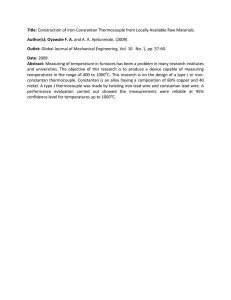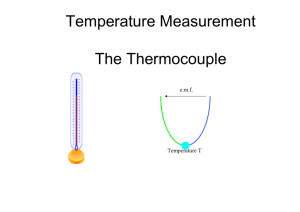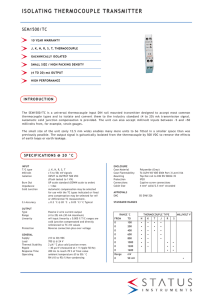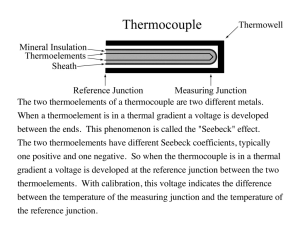AN-369 (Rev. B) - Analog Devices
advertisement
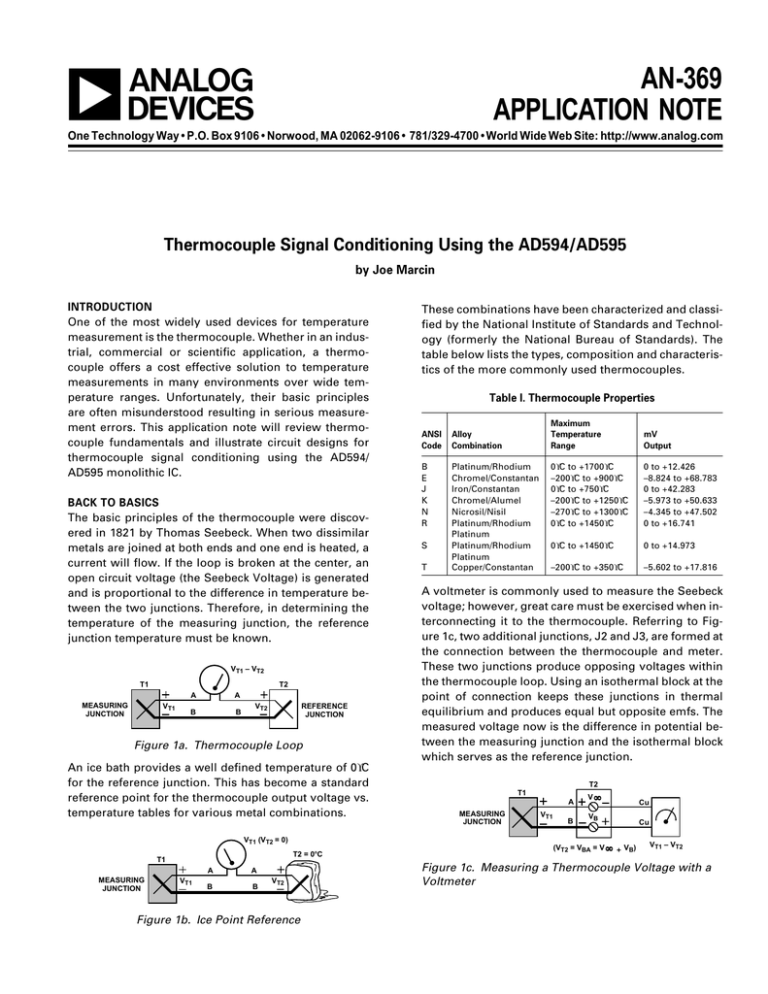
a AN-369 APPLICATION NOTE One Technology Way • P.O. Box 9106 • Norwood, MA 02062-9106 • 781/329-4700 • World Wide Web Site: http://www.analog.com Thermocouple Signal Conditioning Using the AD594/AD595 by Joe Marcin INTRODUCTION One of the most widely used devices for temperature measurement is the thermocouple. Whether in an industrial, commercial or scientific application, a thermocouple offers a cost effective solution to temperature measurements in many environments over wide temperature ranges. Unfortunately, their basic principles are often misunderstood resulting in serious measurement errors. This application note will review thermocouple fundamentals and illustrate circuit designs for thermocouple signal conditioning using the AD594/ AD595 monolithic IC. BACK TO BASICS The basic principles of the thermocouple were discovered in 1821 by Thomas Seebeck. When two dissimilar metals are joined at both ends and one end is heated, a current will flow. If the loop is broken at the center, an open circuit voltage (the Seebeck Voltage) is generated and is proportional to the difference in temperature between the two junctions. Therefore, in determining the temperature of the measuring junction, the reference junction temperature must be known. VT1 – VT2 T1 MEASURING JUNCTION T2 VT1 A A B B REFERENCE JUNCTION VT2 Figure 1a. Thermocouple Loop An ice bath provides a well defined temperature of 0°C for the reference junction. This has become a standard reference point for the thermocouple output voltage vs. temperature tables for various metal combinations. VT1 (VT2 = 0) T2 = 08C T1 A MEASURING JUNCTION VT1 B A B VT2 Figure 1b. Ice Point Reference These combinations have been characterized and classified by the National Institute of Standards and Technology (formerly the National Bureau of Standards). The table below lists the types, composition and characteristics of the more commonly used thermocouples. Table I. Thermocouple Properties ANSI Code Alloy Combination B E J K N R Platinum/Rhodium Chromel/Constantan Iron/Constantan Chromel/Alumel Nicrosil/Nisil Platinum/Rhodium Platinum Platinum/Rhodium Platinum Copper/Constantan S T Maximum Temperature Range mV Output 0°C to +1700°C –200°C to +900°C 0°C to +750°C –200°C to +1250°C –270°C to +1300°C 0°C to +1450°C 0 to +12.426 –8.824 to +68.783 0 to +42.283 –5.973 to +50.633 –4.345 to +47.502 0 to +16.741 0°C to +1450°C 0 to +14.973 –200°C to +350°C –5.602 to +17.816 A voltmeter is commonly used to measure the Seebeck voltage; however, great care must be exercised when interconnecting it to the thermocouple. Referring to Figure 1c, two additional junctions, J2 and J3, are formed at the connection between the thermocouple and meter. These two junctions produce opposing voltages within the thermocouple loop. Using an isothermal block at the point of connection keeps these junctions in thermal equilibrium and produces equal but opposite emfs. The measured voltage now is the difference in potential between the measuring junction and the isothermal block which serves as the reference junction. T2 T1 A MEASURING JUNCTION VT1 B V Cu VB (VT2 = VBA = V Cu + VB) VT1 – VT2 Figure 1c. Measuring a Thermocouple Voltage with a Voltmeter AN-369 PRACTICAL THERMOCOUPLE MEASUREMENT For most applications, it is impractical to use an ice bath for the reference junction. By compensating for the voltage developed at the reference junction, the ice point reference may be eliminated. This is performed by adding a voltage into the thermocouple loop, equal but opposite to that of the reference junction. A circuit that provides cold junction compensation along with amplification and open thermocouple detection is included in the AD594/AD595 family of thermocouple signal conditioning ICs. Although these ICs are specifically calibrated for a Type J or K thermocouple, other thermocouple types may be used with recalibration. Pin connections to internal nodes for the temperature controlled voltages and feedback are provided to perform recalibration. T2 T1 A MEASURING JUNCTION Through the feedback path, the main amplifier maintains a balance at its inputs. In the event of a broken thermocouple or open circuit at the device’s input, these inputs become unbalanced, the fault is detected, and the overload detection circuit drives a current limited n-p-n transistor that may be interfaced as an alarm. VT1 Cu B Cu INTERPRETING AD594/AD595 OUTPUT VOLTAGES To produce a temperature proportional output of 10 mV/°C, and provide an accurate reference junction over the rated operating temperature range, the AD594/ AD595 is gain trimmed at the factory to match the transfer characteristics of Type J and K thermocouples at +25°C. At this calibration temperature, the Seebeck coefficient, the rate of change of thermal voltage with respect to temperature at a given temperature, is 51.70 µV/°C for a Type J thermocouple and 40.44 µV/°C for a Type K. This corresponds to a gain of 193.4 for the AD594 and 247.3 for the AD595 to realize a 10 mV/°C output. Although the device is trimmed for a 250 mV output at +25°C, an input offset error is induced in the output amplifier resulting in offsets of 16 µV and 11 µV for the AD594/AD595 respectively. To determine the actual output voltage from the AD594/AD595, the following equations should be used: Cu VCOMP VT1 – VT2 + VCOMP (VCOMP – VT2) Figure 1d. Cold Junction Compensation THE AD594/AD595 CIRCUIT DESCRIPTION Figure 2 is a block diagram of the AD594/AD595 thermocouple signal conditioner IC. A Type J (for the AD594) or Type K (for the AD595) thermocouple is connected to Pins 1 and 14, the inputs to an instrumentation amplifier differential stage. This input amplifier is contained in a loop that uses the local temperature as its reference. With the IC also at the local temperature, an ice point compensation circuit develops a voltage equal to the deficiency in the locally referenced thermocouple loop. This voltage is then applied to a second preamplifier whose output is summed with the output of the input amplifier. The resultant output is then applied to the input of a main output amplifier with feedback to set the gain of the combined signals. The ice point compensation voltage is scaled to equal the voltage that would be produced by an ice bath referenced thermocouple measuring the IC temperature. This voltage is then summed with the locally referenced loop voltage, the result being a loop voltage with respect to an ice point. –IN –ALM +ALM V+ COMP VO FB 14 13 12 11 10 9 8 AD594 Output = (Type J Voltage + 16 µ V) × 193.4 AD595 Output = (Type K Voltage + 11 µ V) × 247.3 where the Type J and K voltage are taken from the thermocouple voltage tables referred to zero degrees Celsius. It is important to note that a thermocouple’s output is linear over a narrow temperature range. Over a wide temperature range, the Seebeck coefficient introduces nonlinearity. Linearization is not provided by the AD594/ AD595, and any linearization techniques must be performed externally. This entails calculating thermocouple temperature using high order polynomials. The National Institute of Standards and Technology offers tables of polynomial coefficients for a given thermocouple type which may be used in this process. OVERLOAD DETECT AD594/ AD595 +A G G ICE POINT COMP. +TC –TC 1 +IN 2 +C 3 +T 4 5 6 7 COM –T –C V– Figure 2. AD594/AD595 Functional Block Diagram –2– AN-369 Table II. Calculated Errors at Various Ambient Temperatures Ambient Temp. ⴗC AD594C Temp. Rej. Error ⴗC AD594C Total Error ⴗC AD594A Temp. Rej. Error ⴗC AD594A Total Error ⴗC AD595C Temp. Rej. Error ⴗC AD595C Total Error ⴗC AD595A Temp. Rej. Error ⴗC AD595A Total Error ⴗC –55 –25 0 +25 +50 +70 +85 +125 4.83 1.98 0.62 0.00 0.62 1.46 2.25 4.90 5.83 2.98 1.62 1.00 1.62 2.46 3.25 5.90 6.83 3.23 1.25 0.00 1.25 2.59 3.75 7.40 9.83 6.23 4.25 3.00 4.25 5.59 6.75 10.40 5.28 2.04 0.62 0.00 0.62 1.38 1.99 3.38 6.28 3.04 1.62 1.00 1.62 2.38 2.99 4.38 7.28 3.29 1.25 0.00 1.25 2.50 3.49 5.88 10.28 6.29 4.25 3.00 4.25 5.50 6.49 8.88 NOTE Temp. Rej. Error has two components: (a) Difference between actual reference junction and ice point compensation voltage times the gain; (b) Offset and gain TCs extrapolated from 0°C to +50°C limits. Total error is temp. rej. plus initial calibration error. OPTIMIZING PERFORMANCE Cold Junction Errors Optimal performance from the AD594/AD595 is achieved when the thermocouple cold junction and the device are at thermal equilibrium. Avoid placing heat generating devices or components near the AD594/ AD595 as this may produce cold junction related errors. The ambient temperature range for the AD594/AD595 is specified from 0°C to +50°C, and its cold junction compensation voltage is matched to the best straight line fit of the thermocouple’s output within this range. Operation outside this range will result in additional error. Table II shows the maximum calculated errors at various ambient temperatures. Soldering Proper soldering techniques and surface preparation are necessary to bond the thermocouple to the PC tracks. Clean the thermocouple wire to remove oxidation before soldering. Noncorrosive rosin flux may be used with the following solders: 95% tin-5% antimony, 95% tin-5% silver, or 90% tin-10% lead. Bias Current Return The input instrumentation amplifier of the AD594/AD595 requires a return path for its input bias current and may not be left “floating.” If the thermocouple measuring junction is electrically isolated, then Pin 1 of the IC should be connected to Pin 4, the power supply common. In some applications, tying the thermocouple directly to common is not possible. A resistor from Pin 1 to common will satisfy the bias current return path but will, however, generate an additional input offset voltage due to the 100 nA bias current flowing through it. If the thermocouple must be grounded at the measuring junction or if a small common mode potential is present, do not make the connection between Pins 1 and 4. Circuit Board Layout The circuit board layout shown in Figure 3 (with the optional calibration resistors) achieves thermal equilibrium between the cold junction and the AD594/AD595. The package temperature and circuit board are thermally contacted in the copper printed circuit board tracks under Pins 1 and 14. The reference junction is now composed of a copper-constantan (or copper-alumel) connection and copper-iron (or copper-chromel) connection in thermal equilibrium with the IC. IRON (CHROMEL) +T CONSTANTAN (ALUMEL) +C +IN –IN 14 1 +ALM –ALM 7 COMMON –T Noise Suppression When detecting a low level output voltage from a thermocouple, noise reduction is a prime concern. Whether internally generated or induced by radiation from a source, noise becomes one of the limiting factors of dynamic range and resolution. Solving noise problems involves eliminating the source and/or shielding. The latter is more effective when the source cannot be controlled or identified. –C V– AD594 AD595 8 Noise may be injected into the AD594/AD595 input amplifier when using a long length of thermocouple. To determine if this noise path is the culprit, disconnect the thermocouple from the AD594/AD595 and tie Pins 1 and 14 to Pin 4. The output voltage at Pin 9 of the AD594/ AD595 will now indicate ambient temperature (250 mV at +25°C). If the noise at the output (Pin 9) disappears, then shielding on the input is required. Shielded thermocouple wire with the shield connected to Pin 4 of the IC will provide effective noise suppression. If the output COMP VOUT V+ Figure 3. PC Board Layout –3– AN-369 still exhibits noise, it may be entering via the power supply. Proper power supply bypassing and decoupling will alleviate this condition. CONSTANTAN (ALUMEL) 14 –ALM +ALM 13 12 V+ COMP VO FB 11 10 9 8 9 8 ICE POINT COMP. +TC G 1 2 3 4 5 +T 8MV RCAL 100kV 6 7 –T 15MV +15V Figure 5. Optional Calibration OFFSETTING AND GAIN CHANGE The AD594/AD595 is designed to produce a 0 V output at 0°C with a nominal gain of 10 mV/°C, but other ranges are readily possible. The zero output temperature may be changed by applying an offset voltage to Pin 8. The magnitude of this voltage is calculated using the equations for the AD594/AD595 output voltage for a given thermocouple temperature. Gain changes are easily accommodated by adding series resistance to increase gain or by paralleling the nominal 47 kΩ feedback resistor for gain reduction. The following method illustrates this principle. ICE POINT COMP. +TC G 10 –TC IRON (CHROMEL) +A G 11 +A G OVERLOAD DETECT AD594/ AD595 12 AD594/ AD595 Adding capacitance to the frequency compensation pin (Pin 10) rolls off the bandwidth of the AD594/AD595 output amplifier thus limiting noise. Without compensation, the 3 dB bandwidth is approximately 10 kHz. A 0.1 µF capacitor connected between Pins 10 and 11 reduces the 3 dB point to 120 Hz. This technique, however, is only useful if the noise does not drive the input stage into saturation. 14 13 OVERLOAD DETECT Filtering the thermocouple input will attenuate the noise before amplification. Figure 4 illustrates an effective input filter consisting of a resistor in series with Pin 1 and a capacitor from this pin to ground. An offset voltage will result due to the input bias current flowing through the resistor. Since the input bias current for the inverting input (Pin 14) varies with input voltage, any resistance in series with this input would produce an input dependent offset voltage. Therefore, it is highly recommended to connect this pin directly to common. In addition, the capacitor across the input terminals increases the response time for the alarm circuit in the event of a broken thermocouple. –IN VOUT +15V 1. Select a temperature range T1–T2. –TC 1 +IN 2 3 4 5 6 7 +C +T COM –T –C V– 2. Based on this range, determine an output sensitivity (mV/°C) that limits the maximum output excursions from (–VS + 2.5) to (+VS – 2) for dual supplies or from 0 to (+VS – 2) for single supply operation. Figure 4. Input Filtering TRIMMING CALIBRATION ERROR The AD594/AD595, available in two performance grades, is factory trimmed to achieve a maximum calibration error of 1°C or 3°C depending on grade. For most applications, this range of error is acceptable; however, by adding the optional trim circuit shown in Figure 5, this error may be nulled. A negative offset of approximately 3°C is injected into Pin 5. The trimming potentiometer provides a balancing current into Pin 3 thus nulling any calibration error. 3. Calculate the average thermocouple sensitivity over the selected temperature range: (VT1–VT2)/(T1–T2). 4. Divide the desired output sensitivity (mV/°C) by the average thermocouple sensitivity (mV/°C). This yields the new gain (G) for the AD594/AD595. 5. Measure the actual feedback resistance between Pins 8 and 5, RFB. 6. RIN = RFB/193.4 –1 where RFB is the measured feedback resistance. NOTE: Use 247.3 for an AD595 instead of 193.4. 7. The new feedback resistance, REXT = (G × 1)(RIN). –4– AN-369 +5V IN704A 4.1V 182V –10mA/8C CONSTANTAN (ALUMEL) 56kV 2N2222 464V 1kV 14 11 12 14 13 11 12 10 9 8 RFDBK 3 4 5 6 1 2 3 4 5 6 7 RSETUP 5.11V (4.02V) IRON (CHROMEL) 7 Figure 7. Current-Mode Transmission –5V TEMPERATURE-TO-FREQUENCY CONVERSION A digital output format may be produced by converting the AD594/AD595 voltage output to a frequency. This format not only affords noise immunity over long transmission paths but also provides information which may be directly interfaced to a computer. A low cost voltage-to-frequency converter, the AD654, converts the 10 mV/°C voltage output to a TTL compatible square wave output. As shown in Figure 8, the entire system is powered from a single 5 V supply and provides temperature measurements from 0°C to +300°C. Higher thermocouple temperatures will require a higher power supply voltage to maintain a maximum AD594/AD595 output swing of 2.5 V below the supply. The AD594/ AD595 output voltage is connected to the AD654 input through a series resistor to produce a 0 mA to 1 mA full-scale current. Capacitor CT determines the full-scale output frequency with a maximum usable frequency of 500 kHz resulting in 0.4% nonlinearity. Other temperature ranges and output frequencies are achievable. Refer to the AD654 data sheet for additional information. CURRENT MODE TRANSMISSION In many applications, the AD594/AD595 may be located in a noisy, remote location with its output driving a long length of cable. Under these demanding conditions, current transmission offers better noise immunity and eliminates errors due to cable resistance. The circuit shown in Figure 7 converts the AD594/AD595 output to a current and then converts it back to a voltage at the control point. The feedback voltage at Pin 9 forces the voltage across RSENSE to equal the thermocouple voltage. With the values shown for RSENSE, this produces a current output scale factor of 10 µA/°C. Note that the AD594/ AD595 quiescent current flows through the sense resistor, thus limiting the minimum measured temperature to 16°C. The AD711 op amp converts this current back to a nominal 10 mV/°C at the control point. Total error is based upon the AD594/AD595 calibration error and the match between the sense resistor and the 1 kΩ current to voltage conversion resistor at the control point. (OPTIONAL) RCOMP +5V 14 13 12 11 10 OVERLOAD DETECT AD594/ AD595 9 +VS (+5V TO –VS + 30) +VLOGIC CT 8 RPU FOUT OSC/ DRIVER +A FOUT = G ICE POINT +TC COMP. G –TC IRON (CHROMEL) –15V –TC Figure 6. Offsetting and Gain Change CONSTANTAN (ALUMEL) AD711 10mV/8C ICE POINT +TC COMP. G REXT ICE POINT +TC COMP. G 2 (OPTIONAL GAIN TRIM) 100kV +A G –TC 1 8 VOUT = +A G 9 1kV AD594/ AD595 OVERLOAD DETECT AD594/ AD595 10 OVERLOAD DETECT VOUT IRON (CHROMEL) 13 TEMPERATURE OFFSET VOLTAGE CONSTANTAN (ALUMEL) 1 2 3 4 5 6 AD654 R1 R2 7 CR1 –VS (0V TO –15V) COMMON Figure 8. Temperature-to-Frequency Conversion –5– VIN (10V) (R1 + R2) CT AN-369 FAHRENHEIT OUTPUT The AD594/AD595 may be configured to produce a voltage proportional to the temperature on a Fahrenheit scale. Conversion of temperature from a Celsius to Fahrenheit scale involves multiplying degrees Celsius by 9/5 and adding a 32 degree offset. The offset is produced by injecting a 200 nA/°C current into Pin 3 while increasing the feedback resistor to accommodate the gain of 9/5. Output calibration is as follows: +20V CONSTANTAN (ALUMEL) 10mV/8F 14 13 AD594/ AD595 This yields a higher output voltage swing over the useful range of the thermocouple therefore, requiring a higher power supply voltage to maintain a maximum output voltage 2.5 V below the supply. 2 3 4 5 6 7 –5V VOUTAVE (T1, T2, T3 ... TN) +5V (R/N)V 14 13 12 11 10 9 8 OVERLOAD DETECT AD594/ AD595 +A e1 R Cu 300V G ICE POINT +TC COMP. G R Cu 300V –TC IRON (CHROMEL) 598kV AVERAGE TEMPERATURE By connecting a number of thermocouples in parallel to the AD594/AD595 input, an average junction temperature will be measured. As shown in Figure 10, a 300 Ω resistor is placed in series with one side of each thermocouple to limit the current circulating between the thermocouple branches. Based on a thermocouple temperature that is either higher or lower than the mean, a positive or negative voltage drop will be developed. AD595 Output = (Type K Voltage + 719 µV) × 445.14 R Cu 300V 9.1kV Figure 9. Fahrenheit Output AD594 Output = (Type J Voltage + 919 µV) × 348.12 e2 8 ICE POINT COMP. +TC G IRON (CHROMEL) The ideal transfer function based on a Fahrenheit output is: e3 9 –TC 1 3. With the thermocouple connected and measuring 0°C, adjust ROFFSET until the output at Pin 9 reads 320 mV. eN 10 5kV RGAIN 2kV +A G 2. Adjust RGAIN for a p-p output at Pin 9 of 3.481 V (AD594) or 4.451 V (AD595). Cu 11 12 ROFFSET 2kV 7.5kV OVERLOAD DETECT 1. With the thermocouple disconnected, apply a 10 mV p-p, 100 Hz ac signal to Pins 1 and 14. CONSTANTAN (ALUMEL) AD680 1 Cu 2 3 4 5 ISOTHERMAL REGION R 300V Figure 10. Measuring Average Temperature –6– 6 7 compensation now compensates for the reference junction at the IC which must remain between 0°C and +50°C. Note however, that the isothermal block may be at any convenient temperature or location. Unused multiplexer inputs should be connected to common to minimize stray signal pickup. To prevent the AD594/AD595 inputs from “floating” resulting in output saturation, the multiplexer is permanently enabled by connecting its enable input to +5 V. MULTIPLEXED THERMOCOUPLES Multiple thermocouples may be connected to a single AD595/AD595 via an external CMOS analog multiplexer such as the ADG507A. For proper operation, all interconnects between the thermocouples, multiplexer and AD594/AD595 inputs are copper and are held in thermal equilibrium by an isothermal block. As shown in Figure 11, a thermocouple is mounted to measure the IC temperature as well as to cancel the reference junction voltage at the isothermal block. With the multiplexer enabled, the Constantan (Alumel)—Copper junction formed by the thermocouple connection at the isothermal block is in series with a Copper—Constantan (Alumel) junction formed by the reference thermocouple connection. REFERENCES 1. Sheingold, Dan, ed. Transducer Interface Handbook, Analog Devices, 1980. E1796a–0–7/98 AN-369 2. 1992 Amplifier Applications Guide, Analog Devices, Pub. No. G1646–10–4/92. This series combination contributes equal but opposite voltages since the block is isothermal. Under this condition, the AD594/AD595 internal cold junction 3. American Society for Testing and Materials, Manual On The Use Of Thermocouples In Temperature Measurement, ASTM PCN 04-470020-40. CONSTANTAN (ALUMEL) IRON (CHROMEL) REFERENCE JUNCTION VOUT +15V Cu Cu 14 V2 V1 19 20 21 22 23 24 25 26 11 10 9 8 7 6 5 4 Cu Cu Cu Cu Cu Cu Cu Cu Cu Cu Cu Cu Cu Cu Cu Cu IRON (CHROMEL) ISOTHERMAL BLOCK +5V 18 12 11 10 9 8 OVERLOAD DETECT 28 AD594/ AD595 +A G ICE POINT COMP. +TC G 2 –TC 1 2 3 4 5 6 7 –15V 1 ADG507A EN 27 +15V ISOTHERMAL REGION –15V 12 A0 A1 A2 17 16 15 Figure 11. Multiplexed Inputs –7– PRINTED IN U.S.A. CONSTANTAN (ALUMEL) 13
